261 M1 Tanks Getting Trophy Anti-Missile System As Army Reorients To Major Wars
Posted on
PENTAGON: The Army’s 2019 budget will upgrade 261 M1 tanks, enough for three brigades, to carry Israeli-made Trophy Active Protection Systems (APS) to guard against anti-tank missiles, service officials said this morning. That’s just one of many funding changes — from buying more howitzer shells to intensifying training exercises — meant to reorient the Army from its counterinsurgency-era focus on light infantry and helicopters to “great power competition” to deter a potential Russian blitzkrieg.
“If you look at what we’ve done in the last 15 years, it is a light, aviation-centric fight, so we took a fair amount of risk on the heavy force,” said John Daniels, deputy assistant secretary of the Army for Plans, Programs, and Resources. “Now you are at a point where the system is starting to age out….If you look at the ages of platforms and how long it takes to rebuild a heavy brigade, you (need to modernize) about one, 1.5 a year to really make a substantive change.”
Will the Army sustain that rate over the long term? “We’ll have to see how ’19 and ’20 play out,” Daniels said.
[click here to read our overview of the 2019 budget request plus detailed dives in the Army, Air Force, and Navy/Marines]
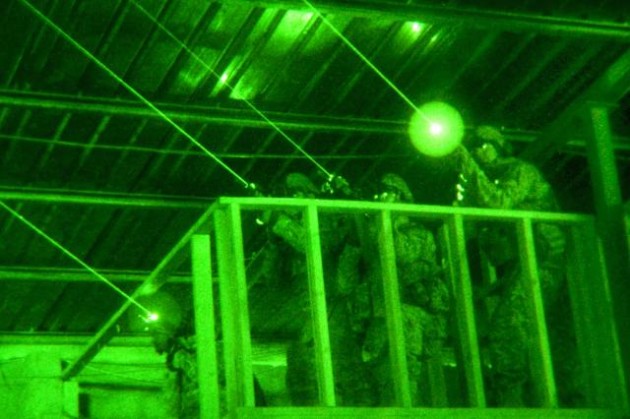
Army soldiers training with laser sights and night vision devices.
Army Modernization In Flux
The five-year budget plan is in flux because Army modernization is in the midst of a major upheaval. A new Futures Command is standing up, radically reorganizing how the Army handles procurement, requirements, and warfighting concepts. Eight high-level Cross Functional Teams already revising spending to better fit Chief of Staff Mark Milley’s top six modernization priorities announced in October, which are all geared for major war. Most of those changes are still a work in progress, officials said, but some early impacts are already being felt.
“There will be some early quick wins,” said Maj. Gen. Paul Chamberlain, the Army’s budget director. The only specific one he’d share, however, was new night vision equipment that would see with greater detail and better depth perception through darkness, smoke, and other obscurants, letting U.S. soldiers move quickly when others are blind.
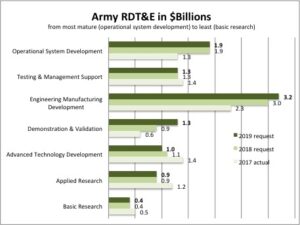 Interestingly, the night vision gear is being pushed by the “soldier lethality” Cross Functional Team, which is sixth and last of Gen. Milley’s top six modernization priorities. As a general rule, priority No. 1 — long-range precision firepower to counter Russian rocket artillery — should get the most additional funding, he said, but the Army will be flexible and reallocate funds to any of the six areas that shows early promise.
Interestingly, the night vision gear is being pushed by the “soldier lethality” Cross Functional Team, which is sixth and last of Gen. Milley’s top six modernization priorities. As a general rule, priority No. 1 — long-range precision firepower to counter Russian rocket artillery — should get the most additional funding, he said, but the Army will be flexible and reallocate funds to any of the six areas that shows early promise.
“Within those six priorities, the No. 1 is Long-Range Precision Fires,” said Chamberlain, “but as the technologies evolve and emerge, if one ends up being more promising than another, we’re going to reinforce success.”
The modernization overhaul’s main impact so far has been on Research, Development, Testing & Evaluation, not procurement. In particular, “demonstration and validation” of promising new systems — a top priority for the new CFTs — is up almost 50 percent in the 2019 request compared to 2018’s, which was itself about 50 percent higher than 2017. (Actual 2018 figures are still being determined because Congress just managed to pass a proper spending bill in the second quarter of the fiscal year).
There’s a smaller increase, 7 percent, in the next stage of getting a system ready to deployment, Engineering & Manufacturing Development (EMD). Other areas of RDT&E are flat or even slightly down, which doesn’t quite fit with Gen. Milley’s call for radical “ten-fold” improvements in technology.
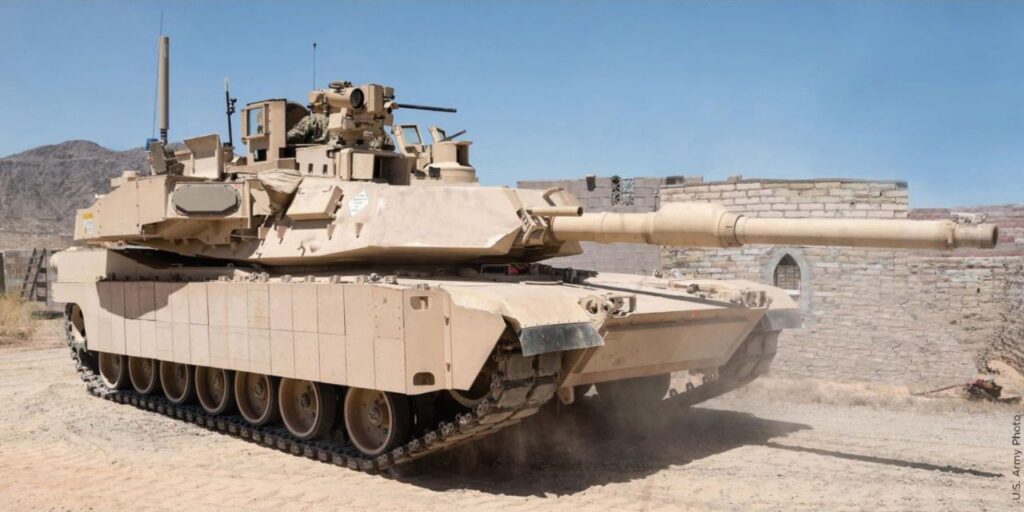
Army M1 Abrams tank with a trial installation of the Israeli-made Trophy Active Protection System (APS)
What to Buy Today to Fight Tonight
No investment is more up in the air than the electronic backbone of the Army, its vulnerable command-and-control networks. The service continues to field Warfighter Information Network – Tactical (WIN-T) Increment 2 systems bought in prior years to all active-duty infantry brigades, the officials said — active-duty armor and all National Guard brigades will stick with Increment 1B — and it will buy spare parts and other sustainment, but it’s not buying the much-criticized WIN-T for any additional brigades. The one big network winner highlighted in this budget is Joint Battle Command – Platform (JBC-P), plussed up almost 60 percent to replace current Blue Force Tracking systems across all formations. But that’s a relatively modest user terminal to go on Army vehicles, rather than a wide-area network backbone like WIN-T.
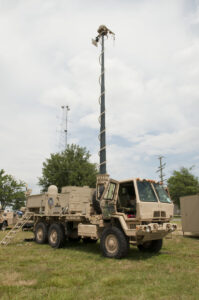
Army WIN-T Tactical Communications Node.
By contrast, there’s been rapid progress and clear direction on Active Protection Systems, which shoot down incoming anti-tank missiles in flight. The M1 is getting the Trophy Active Protection System from Israel’s Rafael. The rival Iron Fist (Israeli Military Industries) and Iron Curtain (Artis, USA) APS for the M2 Bradley and Stryker troop carriers respectively remain in R&D, with procurement timelines and funding to be determined, officials said. The Trophy APS comes on top of other long-planned improvements in the M1 Abrams main battle tank, including new infrared sights, reinforced armor, and improved horsepower and electrical power to handle all the upgrades.
There are other, lower-tech investments too. After years of expending only small quantities of artillery shells against scattered groups of Iraqi and Afghan insurgents, the Army is increasing purchases of 155 millimeter howitzer shells almost eight-fold, from over 16,000 rounds in 2018 to almost 150,000 in 2019. About one percent, 1,189, are Excalibur precision guided rounds, but the vast majority are for old-fashioned barrages against big formations.
Some of the Army’s ammunition stockpiles have aged to the point they must be disposed of, Daniels explained. Meanwhile expenditure in training and testing has increased as the Army reorients to major war, and there’s a higher priority on meeting war plan requirements for ammunition.
“We have a lot of munitions but not enough munitions,” said Davis Welch, the civilian deputy budget director for the Army. “There is hundreds of tons (today) of munitions, everything from small arms to 155 and tank rounds.”
“There is enough ammunition for us to fight tonight,” Maj. Gen. Chamberlain emphasized. But that begs the question of whether there’s enough to fight tomorrow night, next week, next month, and for months after that if a great power war turns into the prolonged grind many experts expect.
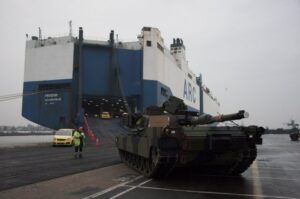
A US Army M1 tank about to be shipped out for the Trident Juncture wargames.
Fighting ASAP, if not tonight, is also the focus of the Army’s intensified program of Emergency Deployment Readiness Exercises (EDREs). (These are largely paid for out of Overseas Contingency Operations (OCO) funds under the European Deterrence Initiative (EDI), although the Army hopes to move them into the more predictable base budget in future years).
In stark contrast to the regular rotations to Iraq and Afghanistan, when a unit would normally know where it was deploying and when at least 180 days in advance — two years in advance for most reserve and Guard units — an EDRE orders a unit to get ready to go without prior warning, as if in wartime. Time to deploy varies widely with the unit and availability of airlift, but “initial” forces are typically on the move in 96 hours.
These snap exercises have occurred on the battalion level so far, but the Army is building up to multiple battalions, complete brigades, and ultimately elements of divisions. Compared to counterinsurgency, where company-sized outposts were the coin of the realm, the increasing scale of wargames shows how much bigger the threat has become.
Subscribe to our newsletter
Promotions, new products and sales. Directly to your inbox.
